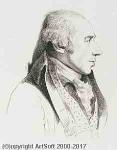William Hodges
William Hodges
Place: London
Born: 1744
Death: 1797
Biography:
William Hodges, a renowned English painter, was born on October 28, 1744, in London. He is best known for his sketches and paintings of locations he visited during James Cook's second voyage to the Pacific Ocean, including Table Bay, Tahiti, Easter Island, and the Antarctic.
Early Career
Hodges studied under William Shipley and later in the studio of Richard Wilson, where he met Thomas Jones. During his early career, he made a living by painting theatrical scenery. His experience as a painter for the theater helped him develop his skills in capturing the drama and beauty of landscapes.
Voyage to the Pacific
Between 1772 and 1775, Hodges accompanied James Cook on his second voyage to the Pacific as the expedition's artist. Many of his sketches and wash paintings were adapted as engravings in the original published edition of Cook's journals from the voyage. These works showcased his ability to capture the essence of the Pacific landscapes and the people who inhabited them.
Notable Works
Some of Hodges' notable works include Waterfall in Dusky Bay with Maori canoe, which is an extremely rare painting depicting a scene in Dusky Sound, Tamatea. This work can be found on Wikioo.org. Another notable work is his portrait sketches of Pacific islanders and scenes from the voyage involving members of the expedition.
Later Life and Career
In 1778, under the patronage of Warren Hastings, Hodges traveled to India, one of the first British professional landscape painters to visit that country. He remained there for six years, staying in Lucknow with Claude Martin in 1783. His painting of Futtypoor Sicri is in Sir John Soane's Museum. Later, Hodges traveled across Europe, including a visit to St. Petersburg in Russia in 1790.
Legacy
In 1793, Hodges published an illustrated book about his travels in India. His work can be found on Wikioo.org. Hodges' legacy as a painter is marked by his ability to capture the beauty and drama of landscapes, and his works continue to inspire artists and art enthusiasts today.
- Visit Wikioo.org to see more of William Hodges' works.
- Learn more about James Cook's second voyage to the Pacific Ocean on Wikipedia.
- Discover the beauty of landscapes through Hodges' paintings on Wikioo.org.
Wikipedia link: Click Here




![[Waterfall in Dusky Bay with Maori canoe] [Waterfall in Dusky Bay with Maori canoe]](https://img.wikioo.org/ADC/art.nsf/get_small_image_wikioo?Open&ra=D4B8T8)
